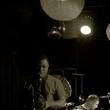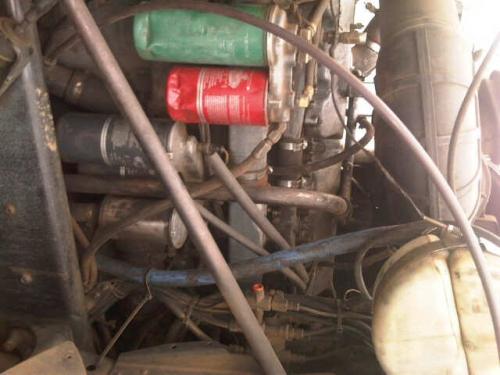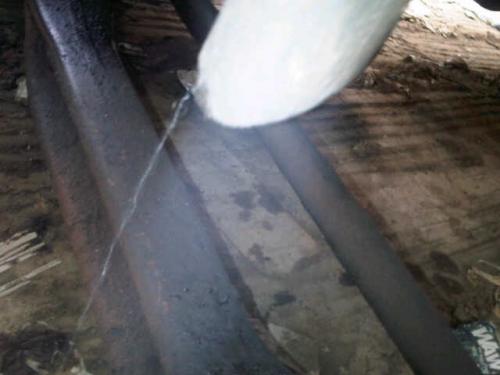-
Posts
32 -
Joined
-
Last visited
Content Type
Profiles
Forums
Gallery
Events
Blogs
BMT Wiki
Collections
Store
Posts posted by Okiki Olufokunbi
-
-
18 hours ago, GreenGiant2 said:
Could the new block had the oil galleys full of crap and got pumped to bearings?
It is very possible. I was not onsite, and cannot vouch for how clean the replacement block was. I was told it was cleaned, but as one of the other poster's mentioned, clean is relative, depending on which part of the world one is. Not as excuse though, it could have been the problem
-
On 6/10/2017 at 3:30 AM, Hobert62 said:
Just a idea ..... But if this is the first they seen coated bearings is it possibles they put it together without assembly lube? That could maybe explain all the bearings looking like this??? Maybe something this simple??
Thanks for the feedback. They used lube oil, and not any specialized assembly lube.
-
44 minutes ago, Mack Technician said:
Looks to me like you just, plain, lost oil.... everything got hit.
Thanks for all your assistance. I am still in not sure why the oil got lost. The engine is being rebuilt again, with non PAI bearing parts this time. Is there a way to check for oil supply to all the journal points with the motor not running? Another failure will be devastating .
-
10 hours ago, Phase 1 said:
"This happened because the connecting rod bolt came loose and the rod came off the crankshaft journal."
I have no experience with this engine but finding a complete rod bolt when there is a thrown rod may not mean that the cause was a loose bolt. I have seen it before and I believe (and others have agreed) that when a rod starts hammering due to a bearing going bad, the pounding can cause a bolt to loosen. If that is what happened, it is possible that the problem you have now also caused the previous failure.
With the thrown rod event, I got that feedback from the driver about an unusual sound, but they did not address this in time. it was the number 5 that threw the rod, I will try to get the details correct, but there was a missing bolt of the connecting rod, and the other was bent.
-
1 hour ago, Mack Technician said:
Second illustration attached.
here is a pic of the crankshaft. I see some scorring on the main bearing journal next to the failed rod bearing journal. The comment about thrust bearing installation ( in the 1 tab location.pdf) is interesting. I expect to receive pics of the main bearings this weekend.
Another question that is arising is why the other rod bearings started wearing down too, and pieces started shaving off them.
-
On 5/24/2017 at 2:37 PM, Crispy2k10 said:
I found out today that the truck had a Cleanfix cooling fan system on it. I contacted Cleanfix and a tech there told me that the fan was set up backwards and is not pulling air into the radiator but blowing the hot air out the front of the truck. I hope that with some more help from them that I can correct the problem soon.
Did the discovery and fix solve the problem?
-
The oil pressure was at 60 psig on idle (2nd startup- prior to failure) , but no one recalls what it was when the engine shut itself down.
-
4 hours ago, Mack Technician said:
Sorry to see it man. PAI is fine quality, one of the owners of PAI have rights to all MACK brand intellectual property. Forget about bearing coating being a factor...it's a non-issue. Only reason that coating wasn't working is because no oil was touching it. Gotta figure out how you lost oil pressure and did not realize it. If you did not lose oil pressure need to figure out how you got over size rod bearings on a standard size crank. They look std size? I'll get you some info ASAP.
Thanks for the response so far . Is the PAI- 8332-P1 an oversized rod bearing? I did order a standard kit from the PAI dealer back then, and the Techs that measured the replacement crank (now damaged) assured us that the replacement was a standard sized crank .
OO
-
Hello folks,
I do need some assistance and help in trying to understand why an E7 PLN engine failed hours after the rebuild. The truck operates out of Africa. I have attached some pics and will attach more as I get them.
The engine had to be rebuilt after it threw a rod, poked a hole in the sleeve and broke the cylinder block. This happened because the connecting rod bolt came loose and the rod came off the crankshaft journal. So the rebuilt involved a new block, and a new crankshaft amongst other things. The truck had an inframe sleeve replacement a year prior, and the pistonless PAI kit was used during the replacement. The PAI Main and rod bearings that came with that sleeve replacement job were not used back then, but was used with this rebuilt. Apparently these PAI rod bearing were coated bearings
After this rebuild, with the installed PAI main and rob bearings, the engine was started up and then left running at idea about 3 hrs. It was then shutdown for about 8 hrs, and restarted again. 2 hours into the second run (at idle), the engine shut itself down and would not restart. After letting the engine cool down, the engine was started up again, but it began to give a knocking sound. It was quickly shutdown, and the oil was drained and the oil pan drop.
The aftermath was ugly my friends. The number 2 cylinder rod bearing had overheated, spun around and extruded. The rod bearing oil hole was virtually plugged off with metal shavings and coating material. The other 5 rod bearing were all scarred up, and already have shavings. Their oil holes were still open, but had already started being plugged with shaving materials. But they did not look like they had spun. The new crankshaft was again shot. It was quite obvious that to me and all so far that the journals seemed to have lost lubrication, but number 2 likely went all the way dry and stopped receiving oil completely. I am trying to understand why, so as to really get to the root cause of the failure.
How does oil get to the individual rod bearings? Unfortunately I don't have my E7 manual with me, but I was under the impression that each of the main bearing got supplied oil from dedicated Engine block oil gallery , and then the main bearing would supply the rod bearings through the oil paths in the crankshaft. Is this incorrect? One of the Tech was contending that the oil flowed down from one journal end of the crankshaft to the other but is he correct?
This was the first time the Techs have ever used coated bearings in any of their rebuilds, to their argument is that the coated PAI connecting rod bearings were not good, and definitely wrong for the application. The Tech are of course skeptical, and contend that the rod bearing started shaving off as soon as the engine was started, and finally the number two shaved off to the point of plugging off the oil hole, stopping oil flow, then overheated. Has anyone here experienced a failure as a result of using coated rob bearings or PAI rod bearings in particular?
Please let me know if you have any more questions or need more information to diagnose. I have my opinions at to what happened, but wanted to get your inputs first. Thank you for you time
OO
-
 1
1
-
-
thank you turckster
OO
-
Hello. I have a 92 CH613 with an E7 non-etech engine. I am getting a fault code 4-3. I look up the code, and read MPH sensor inactive in one source, but the other source says its a clutch fan output sensor error (or something) like that.
Can anyone help to tell me with one it is for my truck, and how to fix it.
Thanks
OO
-
The culprit appears to be leaking core hole plugs in one of the cylinder heads. The two heads were removed, the oil was changed, and the heads were re-installed. Upon starting the engine, one of the heads had some water contamination. The other one looked normal.
Thanks Turckster..
OO
-
Guys,
thanks for the response, but I turned it off prior to asking the question. The heads have been pulled, and they are not leaking or cracked. The water out of the breather is quite cold, so I do not know if this means anything or not. The oil in the sump does not appear to be contaminated.
I will appreciate any help as to what may be causing this issue.
Thank you
OO
-
Hello,
I am getting a stream of water and some steam coming out of the valve cover breather pipe on my CH613 with E7 Vmac non-etec engine. I am also looking coolant/water out of the reservoir. The vehicle has not overheated.The intensity increases as I rev the engine.
I will appreciate any help as to what may be causing this issue.
Thank you
OO
-
thank you MackTech and Farmer...
-
Hello,
I am looking for some information on the mack E6 engine. I will like to buy a mack with an E6 Mechanical 12 valve engine (2 valves per cylinder). I have been reading that some E6 Engines may have 4 valves per cylinder head. Is this statement accurate?
What year macks R model or D models would carry the 12 valve all mechanical E6 engine.
Thanks
OO
-
Thanks first gear.
It smokes black, but we found some bad injectors..
It's a good thing you are in Houston. I may end up sending you some PMs.
Thanks again
-
Hello,
I have a mack E7 non-etec with an electric injection pump. I have a coolant contamination with Diesel fuel. Any idea of where this cross-mixing may be coming from?
Thanks in advance
OO
-
Hello,
I started getting low oil pressure on my 94 CH 613 E7 mechanical truck after replacing one of the cylinder heads. The pressure used to run at 35 psig idle hot , but is now at 15 psig idle hot. We have replaced the oil pump, there is no improvement in the pressure.
Is there an oil relief valve or backpressure regulator, that could have stuck open, on the E7 mechanical engine?
What other things can cause low oil pressure in this engine? I will appreciate any insight.
Thanks
OO
-
thanks folks. we found loose wiring, and it fixed it
-
Hello,
My 94 CH613 with an E7 (non etech) engine just puked a code 3-3 on me
 . This is supposed to be a loss of signal from the injection pump speed sensor.
. This is supposed to be a loss of signal from the injection pump speed sensor.Can someone help with exactly where this sensor is on the pump? a photo of it would be helpful too.
Is this repair typically a wiring fault, or do these sensors really go bad . I can also appreciate it if I can find somewhere online (or local to Houston) to buy this part.
Thanks
OO
-
hello,
i just wanted to inform of the resolution. the ecm was not fried after all, and the electric governor is ok. there was a grounding issue that happened when wires around the air compressor were reconnected after re-installing the compressor. it caused the cyclic revving, and we did not quite figure out why the second ecm did not work
twas quite a painful education, but we keep learning.
thanks
-
Thank you mackpro68. I appreciate the scans.
Just to close out the issue, there was a grounding fault that affected the ecu.
-
Hello all,
I am still dealing with the issues I discussed in the thread below, but I do have a question based on what we are observing now. I am not physically present at the truck in person, but this based on feedback from the folks working on it. The truck is a 1993 CH613 E7 with an electronic injection pump
We got a new ECM as the old one appears to be fried, but it looks like the replacement ECM is unable to rack actuator open to even allow the truck to start. We replaced the electronic governor with another electronic governor, and still had the same result.
The ECM was bypassed, and 12V battery power was fed to the Electronic pump via the harness between the ECM and pump, and the rack actuator (was powered and the vehicle started. This was with both the two electronic racks. With the electronic racks uncoupled from the injection pump, I am told that the ECM still could not power the solenoid to move the actuator rack
The question I have is this. What amount of power (currrent or voltage) should the ECM be sending to the solenoid magnets to move the rack actuator? Is it equivalent to battery power or is the battery power too much?
From all this information, I am concluding that there is something faulty with the ECM we got and I need to try another ECM.
But I will appreciate any other troubleshooting options for power loss between the ECM and the electronic rack on the pump, assuming the ECM is sending out the correct amount of current and voltage to the pump.
Thanks
Link to old thread







E7 engine ruined after 9hrs rebuild - trying to understand why
in Engine and Transmission
Posted
I appreciate everyone's input. I do have an update.
After the techs saw the scarring on the main journal that fed oil to the #2 rod journal, they decided to have the oil pump checked out at another shop. As of now, the rebuilt motor has non coated bearings in it, a serviced oil pump system and a replacement crankshaft. The oil pressure on cold start of the rebuilt engine is now 30 psig instead of 60 psig, which to me is really strange . This can suggest an oil flow restriction issue, or a bearing journal size mismatch ( I don't know if this mismatch can really happen though). But the engine has gone through three 3 hour run on idle operations ( 9 hrs total) , and no reported problems.
It is rather frustrating that no main failure cause could be determined for this engine failure; but it seems to be more oil supply related, or an installation problem, rather than a material of construction issue. But I do feel that the coated bearing will be more prone to initial distress than the non coated ones, for the same amount of oil starvation, because I feel the PTFE based coating may be more prone to cold flow and initially and flake off at a lower temperature than none coated ones. But regardless, oil starvation is bad, period.
Does anyone know if there is an online version of the mack E7 PLN manual available, and where to obtain one? The paper manual one I have is with the Truck in Africa, and I need to really understand the manufacturer designs and specs on these engines, as there are more E7 PLNs added to the fleet.
Thank you all, and I will provide additional updates if there are any,